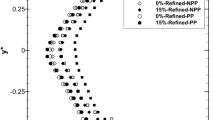Abstract
Computational fluid dynamics (CFD) is used to simulate blood flow inside the fiber bundles of oxygenators. The results are interpreted in terms of flow distribution, e.g., stagnation and shunt areas. However, experimental measurements that provide such information on the local flow between the fibers are missing. A transparent model of an oxygenator was built to perform particle image velocimetry (PIV), to perform the experimental validation. The similitude theory was used to adjust the size of the PIV model to the minimal resolution of the PIV system used (scale factor 3.3). A standard flow of 80 mL/min was simulated with CFD for the real oxygenator and the equivalent flow of 711 mL/min, according to the similitude theory, was investigated with PIV. CFD predicts the global size of stagnation and shunt areas well, but underestimates the streamline length and changes in velocities due to the meandering flow around the real fibers in the PIV model. Symmetrical CFD simulation cannot consider asymmetries in the flow, due to manufacturing-related asymmetries in the fiber bundle. PIV could be useful for validation of CFD simulations; measurement quality however must be improved for a quantitative validation of CFD results and the investigation of flow effects such as tortuosity and anisotropic flow behavior.









Similar content being viewed by others
References
Arens, J., H. Schnöring, F. Reisch, J. F. Vázquez-Jiménez, T. Schmitz-Rode, and U. Steinseifer. Development of a miniaturized heart-lung machine for neonates with congenital heart defect. ASAIO J. 54(5):509–513, 2008.
Arens, J., M. Schoberer, A. Lohr, T. Orlikowsky, M. Seehase, R. K. Jellema, J. J. Collins, B. W. Kramer, T. Schmitz-Rode, and U. Steinseifer. NeonatOx: a pumpless extracorporeal lung support for premature neonates. Artif. Organs 35(11):997–1001, 2011.
Bhavsar, S. S., T. Schmitz-Rode, and U. Steinseifer. Numerical modeling of anisotropic fiber bundle behavior in oxygenators. Artif. Organs 35(11):1095–1102, 2011.
Funakubo, A., I. Taga, J. W. McGillicuddy, Y. Fukui, and R. B. Hirschl. Flow vectorial analysis in an artificial implantable lung. ASAIO J. 49:383–387, 2003.
Graefe, R., R. Borchardt, J. Arens, P. Schlanstein, T. Schmitz-Rode, and U. Steinseifer. Improving oxygenator performance using computational simulation and flow field-based parameters. Artif. Organs 34(11):930–936, 2010.
Hirano, A., K. Yamamoto, M. Matsuda, M. Inoue, S. Nagao, K. Kuwana, M. Kamiya, and K. Sakai. Flow uniformity in oxygenators with different outlet port design. ASAIO J. 55(3):209–212, 2009.
Jones, C. C., M. J. McDonough, P. Capasso, D. Wang, K. S. Rosenstein, and J. B. Zwischenberger. Improved computational fluid dynamic simulations of blood flow in membrane oxygenators from X-ray imaging. Ann. Biomed. Eng. 41:2088–2098, 2013.
Mazaheri, A. R., and G. Ahmadi. Uniformity of the fluid flow velocities within hollow fiber membranes of blood oxygenation devices. Artif. Organs 30(1):10–15, 2006.
Schoberer, M., J. Arens, A. Erben, D. Ophelders, R. K. Jellema, B. W. Kramer, J. L. Bruse, P. Brouwer, T. Schmitz-Rode, U. Steinseifer, and T. Orlikowsky. Miniaturization: the clue to clinical application of the artificial placenta. Artif. Organs 38(3):208–214, 2014.
Schoberer, M., J. Arens, A. Lohr, M. Seehase, R. K. Jellema, J. J. Collins, B. W. Kramer, T. Schmitz-Rode, U. Steinseifer, and T. Orlikowsky. Fifty years of work on the artificial placenta: milestones in the history of extracorporeal support of the premature newborn. Artif. Organs 36(6):512–516, 2012.
Sonntag, S. J., W. Li, M. Becker, W. Kaestner, M. R. Büsen, N. Marx, D. Merhof, and U. Steinseifer. Combined computational and experimental approach to improve the assessment of mitral regurgitation by echocardiography. Ann. Biomed. Eng. 42:971–985, 2014.
Wu, Z. J., B. Gellman, T. Zhang, M. E. Taskin, K. A. Dasse, and B. P. Griffith. Computational fluid dynamics and experimental characterization of the pediatric pump-lung. Cardiovasc. Eng. Technol. 2(4):276–287, 2011.
Wu, Z. J., M. E. Taskin, T. Zhang, K. H. Fraser, and B. P. Griffith. Computational model-based design of a wearable artificial pump-lung for cardiopulmonary/respiratory support. Artif. Organs 36(4):387–399, 2012.
Zhang, J., T. D. C. Nolan, T. Zhang, B. P. Griffith, and Z. J. Wu. Characterization of membrane blood oxygenation devices using computational fluid dynamics. J. Membr. Sci. 288:268–279, 2007.
Zhang, J., M. E. Taskin, A. Koert, T. Zhang, B. Gellman, K. A. Dasse, R. J. Gilbert, B. P. Griffith, and Z. J. Wu. Computational design and in vitro characterization of an integrated maglev pump-oxygenator. Artif. Organs 33:805–817, 2009.
Acknowledgments
This research project is supported by an I3TM-Grant through the RWTH Aachen University. The authors have no proprietary interests in this paper.
Conflict of interest
All authors declare that they have no conflict of interest.
Statement of Human Studies
No human studies were carried out by the authors for this article.
Statement of Animal Studies
No animal studies were carried out by the authors for this article.
Author information
Authors and Affiliations
Corresponding author
Additional information
Associate Editor Hwa Liang Leo oversaw the review of this article.
Peter C. Schlanstein and Felix Hesselmann have contributed equally to this manuscript.
Rights and permissions
About this article
Cite this article
Schlanstein, P.C., Hesselmann, F., Jansen, S.V. et al. Particle Image Velocimetry Used to Qualitatively Validate Computational Fluid Dynamic Simulations in an Oxygenator: A Proof of Concept. Cardiovasc Eng Tech 6, 340–351 (2015). https://doi.org/10.1007/s13239-015-0213-2
Received:
Accepted:
Published:
Issue Date:
DOI: https://doi.org/10.1007/s13239-015-0213-2




